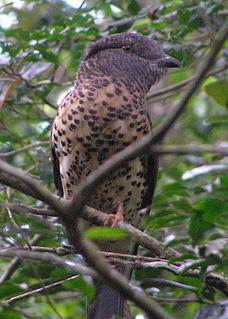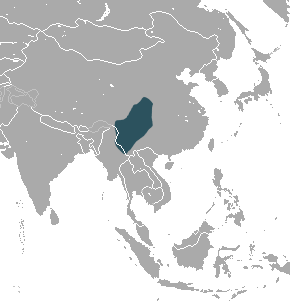
The cuckoo roller or courol is the only bird in the family Leptosomidae, which was previously often placed in the order Coraciiformes but is now placed in its own order Leptosomiformes. The cuckoo roller is at the root of a group that contains the Trogoniformes, Bucerotiformes, Piciformes, and Coraciiformes.

Maxillaria, abbreviated as Max in the horticultural trade, is a large genus of orchids. This is a diverse genus, with very different morphological forms. Their characteristics can vary widely. They are commonly called spider orchids, flame orchids or tiger orchids. Their scientific name is derived from the Latin word maxilla, meaning jawbone, reflecting on the column and the base of the lip of some species, that may evoke a protruding jaw.

The gracilis muscle is the most superficial muscle on the medial side of the thigh. It is thin and flattened, broad above, narrow and tapering below.

Nepenthes gracilis, or the slender pitcher-plant, is a common lowland pitcher plant that is widespread in the Sunda region. It has been recorded from Borneo, Cambodia, Peninsular Malaysia, Singapore, Sulawesi, Sumatra, and Thailand. The species has a wide altitudinal distribution of 0 to 1100 m above sea level, although most populations are found below 100 m and plants are rare above 1000 m. Despite being a widespread plant, natural hybrids between N. gracilis and other species are quite rare.

Poposaurus is an extinct genus of pseudosuchian archosaur from the Late Triassic of the southwestern United States. It belongs to the clade Poposauroidea, an unusual group of Triassic pseudosuchians that includes sail-backed, beaked, and aquatic forms. Fossils have been found in Wyoming, Utah, Arizona, and Texas. Except for the skull, most parts of the skeleton are known. The type species, P. gracilis, was described by M. G. Mehl in 1915. A second species, P. langstoni, was originally the type species of the genus Lythrosuchus. Since it was first described, Poposaurus has been variously classified as a dinosaur, a phytosaur, and a "rauisuchian".

The western spotted skunk is a spotted skunk of western North America.

The Field Elm cultivar Ulmus minor 'Umbraculifera Gracilis' was obtained as a sport of 'Umbraculifera' by the Späth nursery of Berlin c.1897. It was marketed by the Späth nursery in the early 20th century, and by the Hesse Nursery of Weener, Germany, in the 1930s.
The slender harvest mouse(Reithrodontomys gracilis) is a species of rodent in the family Cricetidae. A small mouse-like rodent distributed throughout a portion Central America.

The Talamancan small-eared shrew is a species of mammal in the family Soricidae. It is found in Costa Rica and Panama.

The gracile shrew mole is a species of mammal in the family Talpidae. It is found in China and Myanmar.
Dactylosaurus is a genus of nothosaur in the family Pachypleurosauridae. Along with Anarosaurus, Dactylosaurus was one of the earliest known pachypleurosaurs to come from Europe.
Citrus gracilis, the Humpty Doo lime or Kakadu lime, is a straggly shrub endemic to eucalypt savannah woodlands of Northern Territory, Australia.

Myosaurus is an extinct genus of dicynodont found primarily in Antarctica and South Africa.
Ipomoea gracilis is a plant in the bindweed family, Convolvulaceae. It is found in northern and north-eastern Australia.

Brasiliorchis schunkeana is a species of orchid. The colors of its flower are very close to black, but it is actually a very dark purple-red, giving the impression of a black flower.

Brasiliorchis is a genus of orchid. The genus includes species formerly placed in Maxillaria. It is found in South America.

Brasiliorchis picta is a species of plant in the orchid family native to Brazil, Paraguay and Argentina.
The Field Elm cultivar Ulmus minor 'Viminalis Gracilis' [:'slender'] is a form of U. minor 'Viminalis'. Cultivars listed as Ulmus gracilisHort. by Kirchner (1864), and as U. scabra viminalis gracilisHort. by Dieck (1885), were considered by Green to be forms of Melville's U. × viminalis. A 1929 herbarium specimen held at the Hortus Botanicus Leiden is labelled U. campestris var. viminalis f. gracilis, implying a cultivar that differed from the 'type' tree.
Planipapillus gracilis is a species of velvet worm in the Peripatopsidae family. It is found in Victoria, Australia.












